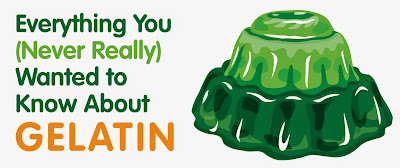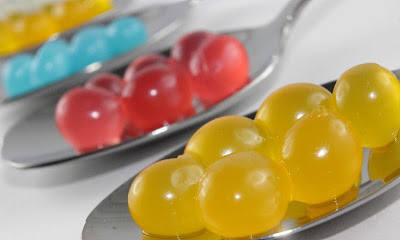The two main uses are as thickening and gelling agents. As thickening agents, they find uses in soups, gravies, salad dressings, sauces and toppings while as gelling agents, they are extensively used in products like jam, jelly, marmalade, restructured foods and low sugar/calorie gels. The role of specific hydrocolloids for thickening and for gel formation is reviewed pinpointing specific applications in food formulations and for product development.
Hydrocolloids form gels by physical association of their polymer chains through hydrogen bonding, hydrophobic association and cation mediated cross-linking and differ from synthetic polymer gels, which normally consist of covalently cross-linked polymer chains. Hence, hydrocolloid gels are often referred to as “physical gels”.
Though all hydrocolloids thicken aqueous dispersions, only a comparatively few gums form gels. In addition, the gels thus formed vary widely in gel character and texture. Hence, knowledge of the conditions is required for gelling of particular hydrocolloid dispersion; the characteristics of the gel produced and the texture it confers are very important aspects to design a specific food formulation. The important gums that find application in food as gelling agents include alginate, pectin, carrageenan, gellan, gelatin, agar, modified starch, methylcellulose and hydroxypropylmethyl cellulose.
Each gelling agent has an optimum concentration range, with the corresponding specific methodologies and possible preparations. The manufacturers provide most of the parameters, but there is often a gap between the industrial application of a product and its practical use in the kitchen. These environments can be very different regarding factors such as equipment; amount of product used, and intended use of the product. One major difference is shelf life—the food industry requires its products to have a long shelf life, while the restaurant kitchen is characterized by immediacy and high turnover of raw materials and preparations.
The principle characteristics and qualities of each of the seven types of gelling agent as well as the differences detected between them and the corresponding commercial products agents are summarized below.
1) HM Pectin
Used throughout the food industry in the production of jams, jellies, and marmalades. One of the most widely used gelling agents for pastry and desserts. Pectin is a natural part of the human diet, but does not contribute significantly to nutrition. The daily intake of pectin from fruits and vegetables can be estimated to be around 5 g (assuming consumption of approximately 500 g fruits and vegetables per day).
Pectin powder
Available in many different gelling strengths. Reacts differently in the presence of sugar and acids. Minerals can be added to improve gelling capability.
Tested product is one of the most widely used products in the food industry that is used to make standard gels.
Is Pectin Gelling Agent Suitable for Vegetarians?
Yes, it appropriate for vegetarians, it is found in fruit and vegetables. It has a high concentration in apples. Gelatin is not vegetarian but agar and pectin are. You can buy high-grade quality at low price from Amazon.com, Click here, classic pectin.
2) Gelatin
Because it is an animal product, gelatin is not suitable for vegans or vegetarians. When cooking or baking, it can sometimes be difficult to find a replacement that faithfully recreates the thickness and texture.
Gelatin - Emulsifier / Gelling Agent
Gelatin has now been classed as food (made of animal skin and hoofs) in its own right. Remember, all types of gelatin are animal based and can be found in dairy products like yoghurts, plus many kinds of confectionery, jellies and other sweets.
Main characteristics
Creates soft and elastic gels that melt at low temperatures (melts in mouth). Food preparations containing gelatin can be frozen and defrosted.
Product varieties
Gelatin sheets and gelatin powder. The two types have different gelling strengths, which are measured in degrees of “bloom”.
Characteristics of product selected for testing
Gelatin sheets are easily dispersed into solution and do not produce residual taste in the final product. Gelatin powder may have some aftertaste.
What are the Alternatives for Gelatin?
Pectin can be used as a gelatin substitute, but is not generally recommended due to the acid and sugar required for proper gelling. It can be tricky to get the right flavor and texture. The Vegetarian Society suggests agar or carrageenan, both of which are derived from seaweed. Like gelatin, they are flavorless and only require water to work. They also are considered easier to use.
3) LM Pectin
Widely used in the food industry to produce jams, jellies, and marmalades with low sugar content.
Pectin powder
This is product is available in a range of gelling strengths, reacts differently with calcium, and can contain minerals to improve gel formation. Modified LM pectins are called LMA (amidated low methoxyl) pectins.
Tested product is the most pure and refined of the conventional LM pectins, which is ideal for preparing low sugar jams.
4) Kappa Carrageenan
Produces fast setting gels that can be prepared instantly. Gel texture is brittle and nonelastic at normal concentrations.
Kappa carrageenan powder
This product is available in many different gelling strengths.
Tested product is one of the most refined available, which contains potassium chloride to improve the gelling process. Final product has almost no residual taste of algae and is also clear – a rare combination.
5) Iota Carrageenan
Resulting gel is soft and elastic, and can be served warm (depending on the concentration used). Resulting gel is thixotropic-it can be broken and will reform. The texture is similar to gels made with gelatin.
Iota carrageenan powder
This product is available in a wide range gelling strengths.
Selected product is very easy to use as it contains sodium chloride, which improves gel formation.
6) Sodium Alginate
Used in spherification technique. Produces thermoirriversible gels that will not melt when heated.
Sodium alginate powder
There is a wide range of products available, with varying amounts of viscosity, gelling capability, and grade of refinement.
The product that we tested produced medium viscosity, and was easy to work with. Can be used for spherification, but leaves a slight residual taste of algae.
7) Agar-Agar
Creates a rigid and brittle gel that can withstand high temperatures. Preferred gelling agent for hot gels.
Agar-agar powder, produced by refining translucent algae filaments.
Agar-agar leaves a very light residual taste. Resulting gel is less opague than other gelling agents.
For the gelation of hydrocolloids, the three main mechanisms proposed are ionotropic gelation, cold-set gelation and heat-set gelation.
Ionotropic gelation occurs via cross-linking of hydrocolloid chains with ions, typically a cation mediated gelation process of negatively charged polysaccharides. Examples of such systems are alginate, carrageenan and pectin.
Ionotropic gelation is carried out by either diffusion setting or internal gelation. In cold-set gelation, hydrocolloid powders are dissolved in warm/boiling water to form a dispersion which on cooling results in enthalpically-stabilized inter-chain helix to form segments of individual chains leading to a three dimensional network. Agar and gelatin form gel by this mechanism. Heat set gels require the application of heat to gel (eg, curdlan, konjac glucomannan, methyl cellulose, starch and globular proteins). It is usually only where heat setting is required in foods (eg, the use of starch in sauces). Heat setting mechanism occurs by unfolding/expansion of native starch/protein and their subsequent rearrangement into a network.
References:
Aguilera JM. 1992. Generation of engineered structures in gels. In: Schwartzberg HG, Hartel RW, editors. Physical chemistry of foods. New York: Marcel Dekker.
Bayarri S, Izquierdo L, Duran L, Costell E. 2006. Effect of addition of sucrose and aspartame on the compression resistance of hydrocolloid gels. Int J Food Sci Technol. [Cross Ref]
Burey P, Bhandari BR, Howes T, Gidley M. 2008. Hydrocolloid gel particles: formation, characterization and application. Crit Rev Food Sci Nutr. [PubMed]
Draget KI. Philips GO, Williams PA, editors. 2000. Alginates. In: Handbook of hydrocolloids. New York: Woodhead Publ Ltd.
Imeson, A. 2013. Thickening and Gelling Agents for Food. Springer. ISBN-10: 1461365775
Laaman, Thomas R. (Editor). 2010. Hydrocolloids in Food Processing. Wiley-Blackwell; 1st edition
Moritaka H, Naito S, Nishinari K, Ishihara M, Fukuba H. 1999. Effects of gellan gum, citric acid and sweetener on the texture of lemon jelly. J Texture Stud. [Cross Ref]
Nishinari K, Zhang H. 2004. Recent advances in the understanding of heat set gelling polysaccharides. Trends Food Sci Technol. [Cross Ref]
Nussinovitch, Amos and Madoka Hirashima. 2013. Cooking Innovations: Using Hydrocolloids for Thickening, Gelling, and Emulsification. CRC Press
Puvanenthiran A, Goddard SJ, Mekinnon IR, Augustin MA. 2003. Milk-based gels made with κ-carrageenan. J Food Sci. [Cross Ref]
Roopa BS, Bhattacharya S. 2008. Alginate gels: I. Characterization of textural attributes. J Food Eng. [Cross Ref]
Thomas WR., Imeson A, editor. 1992. Carrageenans. In: Thickening and gelling agents for food. London: Blackie Academic and Professional.
Tosh S, Marangoni A, Hallet F, Britt I. 2003. Aging dynamics in gelatin gel microstructure. Food Hydrocolloids. [Cross Ref]
Urlacher B, Dalbe B., Imeson A, editor. 1992. Xanthan. In: Thickening and gelling agents for food. London: Blackie Academic and Professional.
Do you like sous vide and good food? Then you must have one of these, 9 Best Cookbooks for Sous Vide Cooking Technique



No comments:
Post a Comment